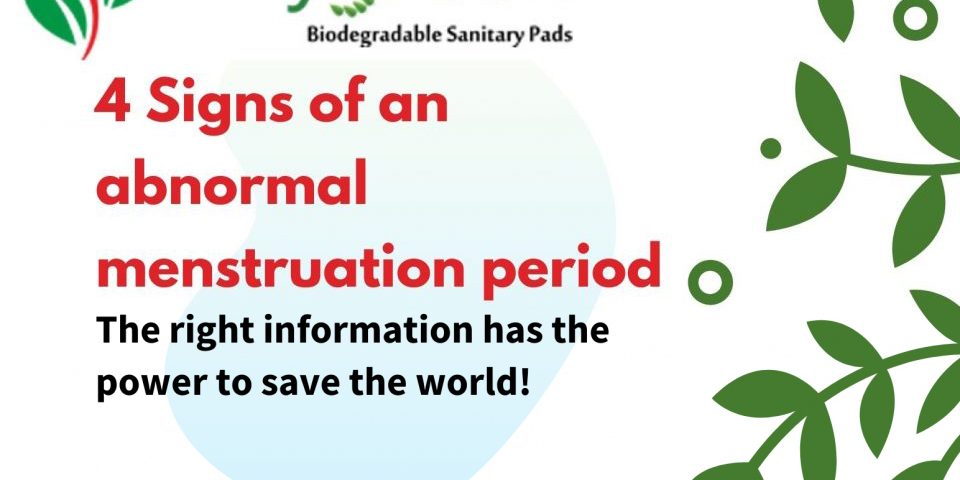4 Signs of an abnormal menstruation period

How to prepare your daughter for her first periods
September 9, 2021
4 ways to get relief from period flu symptoms
November 18, 2021Menstruation is different for each woman. Typically, menstrual periods last for four to seven days. Periods that occur less than 21 days or more than 35 days apart, missing three or more periods in a row, and menstrual flow that is much heavier or lighter than usual are common symptoms of abnormal menstruation.
While there are many causes associated with menorrhagia, the most common causes are:
-
- Menorrhagia & Polymenorrhea
This condition is identified by prolonged, heavy bleeding. There are different forms of this condition. The most common ones are polymenorrhea which means getting periods too frequent, postmenopausal i.e., menstrual periods after menopause, and metrorrhagia which means bleeding between periods.
While there are many causes associated with menorrhagia, the most common causes are:- Hormonal imbalance
- Uterine fibroids
- Miscarriage and other forms of abnormal pregnancy
- Pelvic inflammatory disease (PID)
- Tumors or infections in the pelvic cavity
- Platelet or bleeding disorder
- High concentration of endothelin
The main symptoms of this condition are the need to change sanitary pads very frequently during the day, or when the menstrual period lasts more than seven days. Other symptoms include bleeding or spotting during pregnancy or between menstrual periods.
- Dysmenorrhea
Dysmenorrhea is a condition identified by pain and menstrual cramps during periods. Depending on the causes, the conditions can be classified as primary or secondary. For primary dysmenorrhea, an individual experiences abnormal uterine contractions as a result of a chemical imbalance. Secondary dysmenorrhea is usually associated with medical conditions.Other causes include uterine fibroids, pelvic inflammatory diseases, tumors or infections in the pelvic cavity, and abnormal pregnancy.The condition is more common among women who smoke, are obese, consume excessive alcohol during periods, or started menstruating at an early age. The symptoms of this condition are:
- Pain or cramping in the lower abdomen
- Nausea
- Fatigue
- Dizziness
- Pain in the lower back and legs
- Vomiting
- Headaches
- Amenorrhea
Amenorrhea is a menstrual disorder identified by absent or missed periods for more than three cycles. There are two types of this disorder: primary amenorrhea and secondary amenorrhea.With primary amenorrhea, the menstruation fails to start at puberty. Secondary amenorrhea is when a normal menstrual cycle becomes increasingly irregular or absent.Women may experience this condition for various reasons, usually related to biological changes such as breastfeeding, pregnancy or menopause. It may also occur as a result of medications or health condition such as:
- Obesity
- Ovulation abnormality
- Eating disorder
- Birth defect
- Thyroid disorder
- Excessive exercise
As with any menstrual disorder, early diagnosis and treatment will help to restore normal menstruation.
- Hypomenorrhea
Hypomenorrhea is the opposite of menorrhagia. Hypomenorrhea is a disorder characterized by light periods. The menstruation often lasts less than two days, or it is less than 80ml. The condition can occur as a result of using hormonal contraceptives like oral contraceptives, IUDs or Depo-Provera.
Other causes may include:- Low body fat
- Pregnancy
- Intrauterine adhesions or Asherman’s syndrome
- Nervousness or stress
- Hormonal imbalance
- Premature ovarian failure
As with any menstrual disorder, early diagnosis and treatment will help to restore normal menstruation.
The condition can occur at any stage in a woman’s life, but it is more prevalent just before menopause or after puberty.
Above are the symptoms of each condition, but the question remains when should you contact a medical professional?
- Severe pain during your period or between periods
- Unusually heavy bleeding (soaking through a sanitary pad or tampon every hour for two to three hours) or passing large clots
- An abnormal or foul-smelling vaginal discharge
- High fever
- A period lasting longer than seven days
- Vaginal bleeding or spotting between periods or after you have gone through menopause
- Periods that become very irregular after you have had regular menstrual cycles
- Nausea or vomiting during your period
- Symptoms of toxic shock syndrome, such as a fever over 102 degrees, vomiting, diarrhea, fainting or dizziness
- Menorrhagia & Polymenorrhea
Menstruation is a natural and healthy process. In case you notice any of the above symptoms, it is advisable to see a physician. If you wish to know more or if you wish to try out Staygreen Biodegradable Pads, contact the Staygreen Team.
Buy Staygreen Pads for healthy and happy periods and help yourself as well as the environment.


